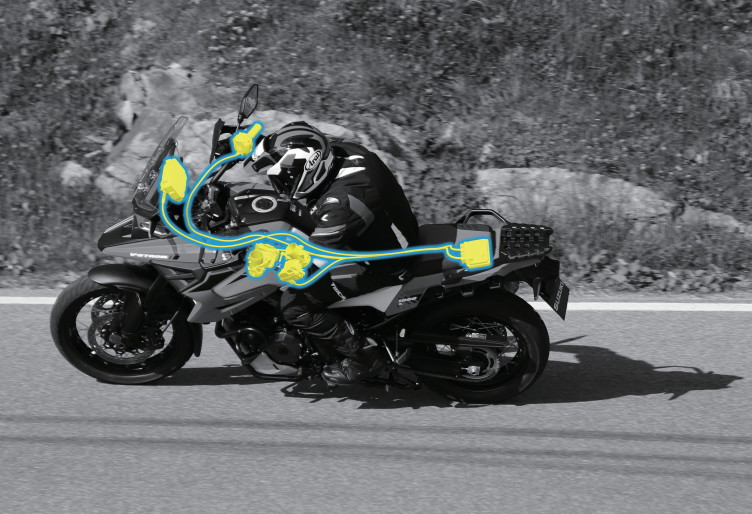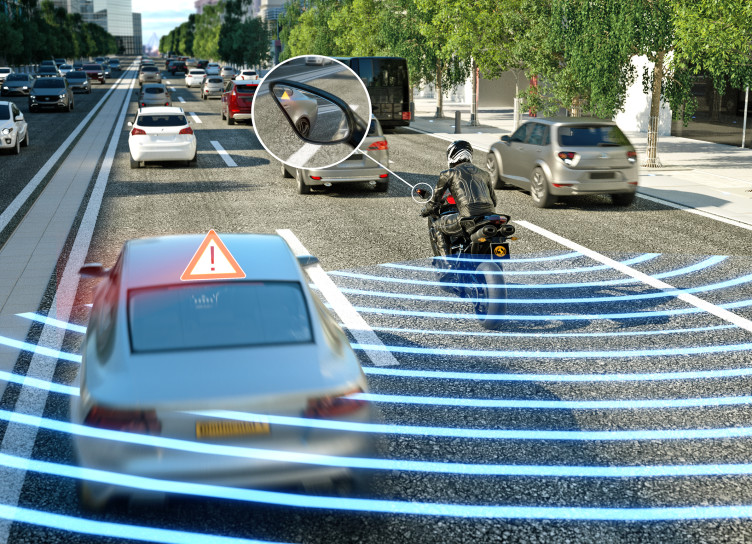Stopping right in time
As signatories of the European Road Safety Charter since 2004, ACEM members committed to progressively equip their street models with advance braking systems (ABS and/or CBS). Moreover, the motorcycle industry supported the introduction of ABS for new motorcycles over 125cc, by progressively introducing very significant number of models with ABS well before the requirements was mandated. Several ACEM members have decided to use ABS as a standard for all their models. The sector has also developed a wide range of technologies that can operate individually or in combination with others, such as cornering ABS, rear wheel lift-off protection, automatic brake force distribution, amplified braking systems and brake by wire.

Traction control systems help riders accelerate, brake and steer properly, efficiently making riding safer and easier.
Seeing and being seen
Being detected by other road users is critical in motorcycle accident prevention. To make visual vehicle detection easier, ACEM members committed to equip all their vehicles with automatic headlamp on technology (AHO) as of 2003. Daytime running lights (DRL) and amber position lights (APL) are also used by the industry to make motorcycles more detectable for other road users.
Other relevant technologies available on the market include polyellipsoid headlamps, full LED lights (headlights, taillights and indicators), projector headlights and adaptive lights which automatically adjust headlights to curves, making night driving considerably safer.
Suspension and stability systems
High-performing suspension systems allow vehicles to adapt to different road surface conditions. They are also necessary for smooth handling and braking, and to keep riders isolated from road bumps. Over the years motorcycle manufacturers have developed a wide range of innovative vehicle suspensions systems for different motorcycle usages.
They include electronic suspension systems, speed-sensitive electronic steering stabilisers, semi-active suspension systems (which adapt the response of the suspension to road conditions, vehicle speed and driving style) and self-regulating suspensions. All these systems allow maximum stability and increase users’ control of the vehicle.

Vehicle stability systems combine stability control, traction control, ABS and dynamic power steering to improve the safety of the rider.
Rider assistance systems for motorcycles
Rider assistance systems can help prevent accidents and contribute to collision reduction by supporting the riders in critical situations. They also enhance enjoyment and convenience by making life easier for riders. Relevant examples include: traction control systems (TCS), tyre pressure monitoring systems (TPMS), electronic adjustable suspension, electronic cruise control, gear shift assistant, fuel economy assistant, proximity activation systems (i.e. keyless riding systems), in-vehicle navigation systems, adjustable vehicle riding modes, side view assist, automatic stability control, etc.
“assistance systems can help prevent accidents and contribute to collision reduction by supporting riders in critical situations”
It is important to understand that many advanced driver assistance systems were initially engineered for cars. However, they can be potentially dangerous if applied to motorcycles without a dedicated approach. This is why ACEM members work on specific engineering solutions for rider assistance technology.
Advanced rider assistance systems: outlook
Recently some manufacturers have developed devices that provide for adaptive cruise control, forward collision warnings and even blind spot detection, all of which will contribute to increase the level of safety for motorcyclists.
The technology underpinning these systems is a combination of radar sensor, brake system, engine management and HMI (human machine interface). Some motorcycle manufacturers will include the new rider assistance systems in their models as of 2020.

Blind spot detection technology will contribute to increase the level of safety for motorcyclists across Europe. Copyright: Continental



